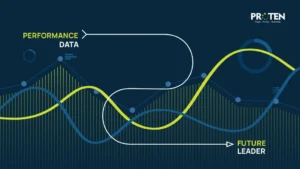If you play games for leisure, you’re probably familiar with that rush of satisfaction after finally conquering a challenging level. Even more excitingly, when you’re rewarded for passing with an item you have silently pleaded to the game to give you. When you’ve achieved this, you can finally rest, with the motivation that upon your return to the game, there’s a coveted item in your inventory that you will put to good use.
That feeling of accomplishment, that surge of motivation to keep playing – that’s exactly what we want to cultivate in our employees. Many see performance management as simply a system for evaluation, but what if we told you it could be the key to unlocking the same level of fulfillment and motivation in your workforce?
Just like that winning item in a game, well-implemented performance management can provide your employees with a sense of accomplishment – acknowledging their hard work, recognizing their achievements, and fueling their desire to keep striving for excellence. In this article, we’re going to dig a bit into the psychology behind this connection, explaining how positive performance management practices can foster a sense of value, purpose, and growth within your team.
Because we understand the effect performance management has on employee morale, we’ll help you move beyond the traditional view of performance reviews as a one-sided evaluation, and explore how to leverage this system to create a culture of recognition, growth, and ultimately, happier, more engaged employees.
By the end of this article, you’ll have a clear understanding of how to transform performance management from a dreaded chore into a tool so powerful, that you’ll see nothing but productivity and engagement from a successful workforce.
Understanding The Connection Between Performance Management and Morale
Imagine resuming every day to an office where your employees walk into work feeling unseen, unheard, and undervalued. Their days are filled with uncertainty about expectations and a gnawing sense that their contributions go unnoticed. This, unfortunately, is the reality for many employees under a poorly designed performance management system.
Traditional, one-sided reviews that focus solely on shortcomings can be incredibly demotivating. Your employees crave purpose and the feeling that their work matters. If your feedback is infrequent, unclear, or solely critical, it will leave them feeling lost and unsure of how to improve. This lack of direction and recognition breeds frustration and ultimately, low morale.
On the other hand, a well-structured performance management system built on open communication and transparency fosters a completely different work environment. When employees have clear expectations and understand how their role contributes to the bigger picture, they feel a sense of ownership and purpose. Regular feedback – both positive and constructive – becomes a valuable tool for growth. They see performance management not as a judgment, but as a collaborative effort to help them excel.
This positive reinforcement loop fuels employee morale. Recognition for achievements, big and small, validates their hard work and motivates them to keep striving. Performance management becomes a platform for open dialogue, allowing employees to voice their concerns and aspirations.
This two-way communication builds trust and fosters a sense of value within the organization. Ultimately, it creates a work environment where employees feel supported, empowered, and excited to contribute their best work.
Building a Positive Performance Management Culture
Shifting your performance management system from a source of apprehension to a driver of morale requires a cultural transformation within your organization. Here, we’ll explore the key elements of building a positive performance management culture:
I. Open Communication and Transparency:
The foundation of a positive performance management culture and even a positive work culture altogether, rests on open and honest communication. Your employees must feel comfortable voicing concerns, asking questions, and seeking feedback. As a leader, you must be approachable and set the tone by actively listening and providing clear, transparent expectations. This fosters trust and allows your employees to see performance management as a collaborative journey, not a unilateral judgment.
II. Clear Expectations and Goal Setting:
If your employees are unsure of what’s expected of them, how do you expect them to feel a sense of accomplishment? Setting clear, measurable goals at the beginning of a performance cycle is crucial. These goals should be developed collaboratively, ensuring your employees understand not just the “what” but also the “why.” This connection to the bigger picture fosters a sense of ownership and purpose, motivating them to achieve the set goals.
III. Regular Feedback and Coaching:
Feedback shouldn’t be a once-a-year event. Regular formal and informal check-ins allow for course correction, celebrate achievements, and identify areas for improvement. The focus should be on constructive feedback, delivered in a timely and actionable manner. This ongoing coaching empowers your employees to learn and grow, fostering a culture of continuous improvement and boosting their confidence.
IV. Recognition and Reward:
A well-designed performance management system acknowledges and rewards achievements. This can be through formal recognition programs, public praise, or even personalized rewards. The key is to ensure the recognition is meaningful and aligns with individual preferences. Feeling valued and appreciated is a significant morale booster.
V. Focus on Development:
Performance management shouldn’t just be about evaluating past performance, but also about future growth. By identifying employee strengths and weaknesses, the system can be used to create personalized development plans. Offering training opportunities, mentorship programs, and clear career paths demonstrates the organization’s investment in its employees’ growth, fostering a sense of loyalty and morale.
VI. Leadership Buy-In:
For a positive performance management culture to flourish, leadership buy-in is essential. Leaders need to champion the system, actively participate in performance conversations, and model the behaviors they expect from managers. Their commitment sends a powerful message that employee development and well-being are valued within the organization.
Using Performance Management For Recognition and Rewards
Recognition is a fundamental human need. When our efforts go unnoticed, it can be incredibly demotivating. Performance management, when used strategically, can be a powerful tool for recognizing and rewarding employees, ultimately boosting morale and driving engagement.
One of the key benefits of a well-designed performance management system is its ability to identify and celebrate top performers. Formal recognition programs that acknowledge achievements publicly can be a great morale booster. However, recognition doesn’t have to be grand gestures. A simple “thank you” or a personalized note from a manager highlighting a job well done can have a significant impact.
The key to effective recognition lies in meaningfulness. A one-size-fits-all approach won’t resonate with everyone. Understanding your employees’ preferences and tailoring recognition accordingly is crucial. For some, public praise might be ideal, while others might appreciate a more private acknowledgment or a reward that aligns with their interests.
Performance management can also be leveraged to establish a reward system that incentivizes desired behaviors and exceptional performance, which is usually measured. This recognition doesn’t necessarily have to be financial. While bonuses and raises can be powerful motivators, consider incorporating non-monetary rewards as well. These could include additional vacation days, flexible work arrangements, or the opportunity to work on a coveted project.
The important aspect is to ensure the rewards are seen as valuable and directly tied to performance. By linking recognition and rewards to achievements identified within the performance management system, you create a clear connection between effort, performance, and appreciation. This reinforces positive behaviors, motivates employees to strive for excellence, and ultimately, contributes to a more engaged and satisfied workforce.
Empowering Employees Through Performance Management
Traditionally, performance management has been viewed as a top-down approach, with managers dictating expectations and evaluating results. However, a new wave of performance management is emerging, one that focuses on empowering employees to take ownership of their development and growth.
This shift empowers employees by fostering a growth mindset. A growth mindset encourages the belief that skills and abilities can be developed through effort and learning. Performance management conversations become opportunities to identify areas for improvement, set goals for development, and equip employees with the resources they need to succeed. This not only empowers them to take control of their careers but also fosters a sense of ownership over their work.
A key aspect of empowering your employees through performance management is creating a development-oriented culture. Regular performance discussions create opportunities to explore employee aspirations and career goals. By aligning these goals with your company’s needs, the performance management system can be used to create personalized development plans. This could involve offering training opportunities, mentorship programs, or even stretch assignments that challenge employees and allow them to learn new skills.
Investing in employee development demonstrates the organization’s commitment to their growth and well-being. This, in turn, fosters a sense of loyalty and motivates your employees to go the extra mile, knowing their contributions are valued and their futures are considered. Ultimately, empowered employees feel more confident, capable, and engaged in their work, leading to a more positive and productive work environment.
Overcoming Challenges
Transforming your performance management system won’t happen overnight (when it’s not jazz), and there will be hurdles to overcome. Here’s how to navigate some of the most common challenges:
- Manager Resistance: Shifting from a traditional, top-down approach to a more collaborative one requires you to change your mindset. Providing training and support to equip them with the necessary skills for conducting effective performance conversations and delivering constructive feedback is crucial.
- Time Constraints: Implementing a robust performance management system can seem time-consuming for you. However, investing the time upfront in clear goal setting, regular check-ins, and focused feedback sessions can save time in the long run by reducing confusion, improving performance, and minimizing the need for last-minute interventions.
- Inconsistency: For a performance management system to be effective, it needs to be applied consistently across the organization. Developing clear guidelines and providing ongoing training for yourself and other managers in your company, helps ensure everyone is on the same page and applying the system fairly.
Measuring the Impact of your new performance management system is essential for demonstrating its effectiveness and securing continued buy-in. Track employee engagement metrics, satisfaction surveys, and performance data to showcase the positive impact on morale and overall organizational success.
By acknowledging these challenges and proactively developing solutions, you can create a sustainable performance management culture that empowers employees, boosts morale, and drives long-term success for your organization.
In Conclusion…
Performance management, when implemented strategically, can be a powerful tool for boosting employee morale. By fostering a culture of open communication, clear expectations, and regular feedback, you create an environment where employees feel valued, empowered, and motivated to excel.
Recognizing and rewarding achievements through the performance management system further fuels morale and reinforces positive behaviors. The shift from a traditional, top-down approach to an empowering, growth-oriented system requires effort, but the rewards are substantial.
A positive performance management culture leads to a more engaged, productive, and ultimately, successful workforce. When employees feel their contributions are valued and their futures are invested, they’re more likely to go the extra mile, leading to a thriving and competitive organization.
So, rethink your approach to performance management. Don’t see it as a chore but as an opportunity to unlock the full potential of your greatest asset – your employees. By fostering a culture of growth, recognition, and empowerment, you’ll transform performance management from a dry evaluation process into a wellspring of employee morale, propelling your organization toward long-term success.










